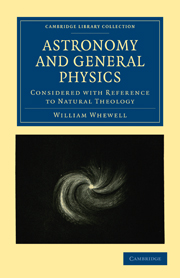Book contents
- Frontmatter
- NOTICE
- Contents
- INTRODUCTION
- BOOK I TERRESTRIAL ADAPTATIONS
- BOOK II COSMICAL ARRANGEMENTS
- CHAP. I The Structure of the Solar System
- CHAP. II The Circular Orbits of the Planets round the Sun
- CHAP. III The Stability of the Solar System
- CHAP. IV The Sun in the Centre
- CHAP. V The Satellites
- CHAP. VI The Stability of the Ocean
- CHAP. VII The Nebular Hypothesis
- CHAP. VIII The Existence of a Resisting Medium in the Solar System
- CHAP. IX Mechanical Laws
- CHAP. X The Law of Gravitation
- CHAP. XI The Laws of Motion
- CHAP. XII Friction
- BOOK III RELIGIOUS VIEWS
CHAP. I - The Structure of the Solar System
from BOOK II - COSMICAL ARRANGEMENTS
Published online by Cambridge University Press: 05 August 2011
- Frontmatter
- NOTICE
- Contents
- INTRODUCTION
- BOOK I TERRESTRIAL ADAPTATIONS
- BOOK II COSMICAL ARRANGEMENTS
- CHAP. I The Structure of the Solar System
- CHAP. II The Circular Orbits of the Planets round the Sun
- CHAP. III The Stability of the Solar System
- CHAP. IV The Sun in the Centre
- CHAP. V The Satellites
- CHAP. VI The Stability of the Ocean
- CHAP. VII The Nebular Hypothesis
- CHAP. VIII The Existence of a Resisting Medium in the Solar System
- CHAP. IX Mechanical Laws
- CHAP. X The Law of Gravitation
- CHAP. XI The Laws of Motion
- CHAP. XII Friction
- BOOK III RELIGIOUS VIEWS
Summary
In the cosmical considerations which we have to offer, we shall suppose the general truths concerning the structure of the solar system and of the universe, which have been established by astronomers and mathematicians, to be known to the reader. It is not necessary to go into much detail on this subject. The five planets known to the ancients, Mercury, Venus, Mars, Jupiter, Saturn, revolve round the sun, at different distances, in orbits nearly circular, and nearly in one plane. Between Venus and Mars, our Earth, herself one of the planets, revolves in like manner. Beyond Saturn, Uranus has been discovered describing an orbit of the same kind; and between Mars and Jupiter, four smaller bodies perform their revolutions in orbits somewhat less regular than the rest. These planets are all nearly globular, and all revolve upon their axis. Some of them are accompanied by satellites, or attendant bodies which revolve about them; and these bodies also have their orbits nearly circular, and nearly in the same plane as the others. Saturn's ring is a solitary example, so far as we know, of such an appendage to a planet.
These circular motions of the planets round the sun, and of the satellites round their primary planets, are all kept going by the attraction of the respective central bodies, which restrains the corresponding revolving bodies from flying off.
- Type
- Chapter
- Information
- Publisher: Cambridge University PressPrint publication year: 2009First published in: 1833



